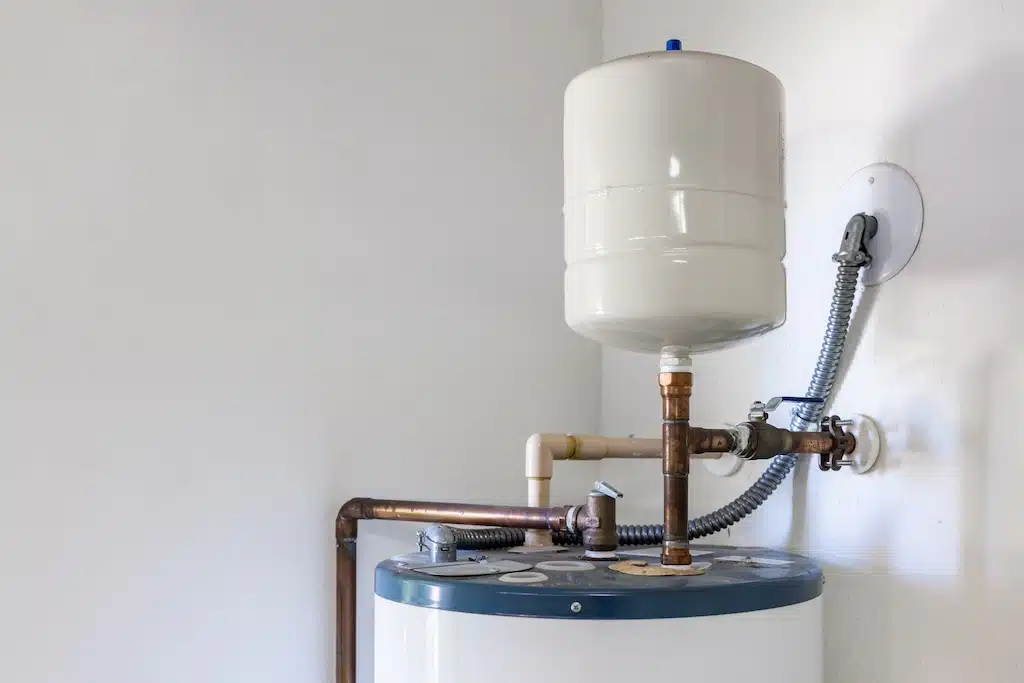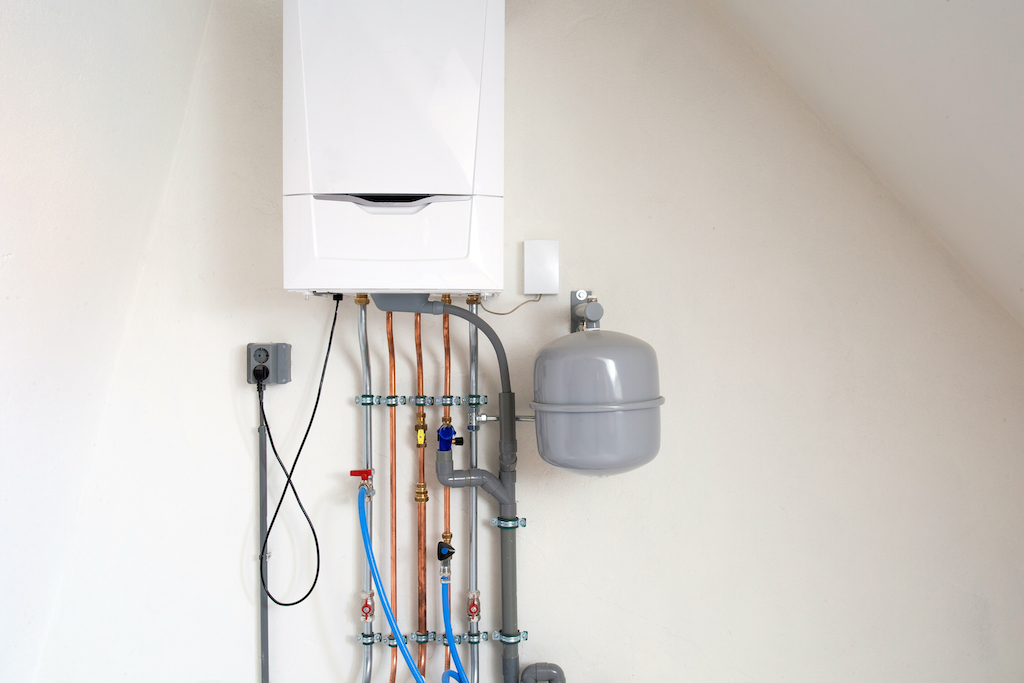
Expansion Tank Essentials: Secure Your Home’s Plumbing
Have you ever wondered how your home’s plumbing system maintains pressure without causing damage? The answer lies in a small but crucial component: the expansion tank.
This device plays a pivotal role in ensuring the longevity and efficiency of your plumbing.
In this article, we delve into the world of expansion tanks. You’ll learn about their function, importance, and how they can save you from costly plumbing disasters.
Whether you’re a new homeowner or looking to upgrade your system, this guide is tailored for you.

Photo By A-photographyy at ShutterStock
What is an Expansion Tank?
An expansion tank is a small but vital component in your home’s plumbing system, particularly if you have a closed water heating system.
This compact vessel plays a crucial role in maintaining the integrity and efficiency of your plumbing.
At its core, the primary function of an expansion vessel is to absorb excess water pressure caused by thermal expansion.
When water is heated, it expands. In a closed plumbing system, this expansion creates additional pressure.
Without a way to accommodate this increased pressure, your system could be at risk. Pipes may strain, joints could begin to leak, and in severe cases, your water heater might even be damaged. This is where the expansion vessel comes in.
The design of an expansion vessel is relatively straightforward yet ingenious. It typically consists of a steel or composite vessel, divided internally by a rubber diaphragm.
One side of this diaphragm is connected to the plumbing system and is filled with water, while the other side contains air or an inert gas, like nitrogen.
As water in your system heats up and expands, it pushes against the diaphragm, compressing the air on the other side. This action effectively absorbs the increased pressure, preventing it from stressing your plumbing fixtures and pipes.
But the role of an expansion vessel goes beyond just protecting against the occasional spike in pressure.
Consistent pressure fluctuations, which are common in heating systems, can lead to wear and tear over time. By mitigating these fluctuations, an expansion vessel extends the life of your plumbing components, from pipes and valves to the water heater itself.
This not only saves you from potential damage and costly repairs but also ensures that your system operates more efficiently.
For homeowners, particularly those in areas with a broad range of temperatures or those using systems like boilers or water heaters, having an expansion vessel is not just a recommendation—it’s often a necessity.
It’s a small investment that safeguards against significant problems, ensuring that your home’s plumbing system remains robust and reliable.
An expansion vessel is an essential component for any homeowner looking to maintain a safe and efficient plumbing system.
It’s a testament to how a simple device can provide a significant impact, offering peace of mind and protection against the unseen forces of thermal expansion in your water system.
How Does an Expansion Tank Work?
Understanding how an expansion tank functions is key to appreciating its importance in your home’s plumbing system.
At its most basic, the expansion vessel is designed to manage the physical principle that water expands when heated. This expansion can create significant pressure within a closed plumbing system, which, if not properly managed, can lead to various problems.
The core component of an expansion vessel is a rubber diaphragm, which effectively divides the tank into two separate chambers.
One side of this diaphragm is connected to the waterline of your plumbing system, known as the water chamber. The other side, known as the air chamber, is filled with air or an inert gas, typically nitrogen. This design is crucial for the tank’s operation.
As the water in your system heats up, it begins to expand. This expansion increases the pressure within your plumbing system. In a system without an expansion vessel, this increased pressure has nowhere to go, which can strain pipes and fixtures, potentially leading to leaks or even bursts.
However, with an expansion vessel installed, this excess water flows into the tank and pushes against the rubber diaphragm.
The action of the water pushing against the diaphragm compresses the air in the air chamber. Air, being compressible, absorbs this pressure, acting like a cushion against the water pressure.
This process of compression and decompression in the expansion vessel helps to balance and regulate the pressure within your plumbing system. It’s a dynamic process, constantly adjusting as the water temperature and pressure fluctuate.
In terms of expansion tank installation, it’s typically connected to the cold water supply line near the water heater. This placement is strategic, as it allows the tank to effectively manage the pressure fluctuations caused by the heating of water.
Proper installation is crucial for the expansion vessel to function effectively and efficiently.
Regular maintenance, including checking the air pressure in the tank and inspecting for leaks, is also essential. This ensures that the expansion vessel continues to operate as intended, providing peace of mind and preventing potential damage to your plumbing system.
The tank works by using a simple yet effective mechanism to balance the pressure in your plumbing system caused by thermal expansion. Its role is vital in preventing damage and maintaining the efficiency and longevity of your plumbing infrastructure.
For homeowners, understanding and maintaining your expansion vessel is a key aspect of responsible home maintenance.
Types of Expansion Tanks
When it comes to managing the pressure in your home’s plumbing system, understanding the different types of expansion vessels is crucial.
Primarily, there are two main types: bladder expansion vessels and diaphragm expansion vessels. Each type has its unique features and applications, making them suitable for various plumbing systems.
Bladder Expansion Tanks
Bladder expansion vessels are characterized by a bladder or balloon-like bag inside the tank, which holds water. This bladder is made of a durable material, typically rubber, and is completely sealed from the air chamber of the tank.
How They Work
In a bladder expansion vessel, water enters the bladder under pressure. As the water expands due to heating, it compresses the air in the outer chamber of the tank. The bladder ensures that the water and air never mix, reducing the risk of corrosion and extending the tank’s lifespan.
Applications
Bladder expansion tanks are often used in residential water systems, especially in areas where water quality might lead to corrosion.
They are also preferred in systems where maintaining a barrier between the water and air is crucial for preventing contamination and ensuring the longevity of the tank.
Diaphragm Expansion Tanks
Diaphragm expansion vessels, on the other hand, feature a diaphragm that is permanently attached to the interior of the tank. This diaphragm separates the water chamber from the air chamber but, unlike the bladder tank, it is not removable.
How They Work
The diaphragm in these tanks flexes as water pressure changes, allowing for the absorption of the increased pressure due to thermal expansion.
As the water heats and expands, it pushes against the diaphragm, compressing the air on the other side. This helps in balancing the pressure within the plumbing system.
Applications
Diaphragm expansion vessels are commonly used in both residential and commercial plumbing systems. They are particularly effective in systems where space is a constraint, as they tend to be more compact.
Additionally, they are often easier to install and maintain, making them a popular choice for many homeowners and professionals.
Both bladder and diaphragm expansion vessels play a vital role in maintaining the health and efficiency of plumbing systems.
The choice between the two often depends on specific system requirements, space availability, and maintenance preferences. Understanding these types can help in making an informed decision for expansion tank installation and ensuring the smooth operation of your plumbing system.
Importance of Expansion Tanks
Understanding the critical role of expansion vessels in your home’s plumbing system is essential for maintaining its integrity and functionality.
These tanks are not just additional components; they are vital in managing the pressures within your system, thereby preventing a range of potential issues.
Preventing Damage Due to Pressure Fluctuations
Expansion vessels are designed to handle the increased pressure caused by the thermal expansion of water.
When water is heated, it expands, and in a closed plumbing system, this expansion can lead to excessive pressure buildup. This is where the expansion vessel comes into play.
How They Protect: By absorbing the extra pressure, expansion vessels prevent this buildup from reaching dangerous levels.
Without an expansion vessel, the increased pressure can lead to pipe bursts, which are not only costly to repair but can also cause significant water damage to your home.
Safeguarding Plumbing Fixtures and Appliances
Another critical aspect of expansion vessels is the protection they offer to your plumbing fixtures and appliances.
High pressure can strain various components of your plumbing system, including valves and joints.
Protecting Water Heaters: One of the most vulnerable appliances to pressure damage is the water heater. The expansion vessel helps in maintaining a balanced pressure, thus extending the life of your water heater and preventing potential malfunctions or failures.
Compliance with Plumbing Codes
In many areas, having a tank is not just a precautionary measure but a requirement. Plumbing codes often mandate the installation of expansion tanks, especially in systems with a closed-loop configuration.
Code Compliance: Ensuring that your plumbing system complies with local codes is crucial not only for the safety and efficiency of your system but also for legal compliance.
Expansion vessel installation can be a key factor in meeting these regulations.
Enhancing System Efficiency
Beyond preventing damage, expansion vessels contribute to the overall efficiency of your plumbing system.
By managing pressure fluctuations, they ensure that your system operates smoothly, reducing the risk of leaks and minimizing wear and tear on pipes and fixtures.
The importance of expansion vessels in residential plumbing cannot be overstated. They are essential for preventing damage due to pressure fluctuations, safeguarding plumbing fixtures and appliances, ensuring compliance with plumbing codes, and enhancing the overall efficiency of your system.
Whether you’re installing a new system or upgrading an existing one, considering the inclusion of an expansion vessel is a wise and necessary decision.
Expansion Tank Installation
Proper installation of an expansion vessel is a critical step in ensuring the effective functioning and longevity of your home’s plumbing system.
While the concept might seem straightforward, the process involves specific considerations to ensure optimal performance and safety.
Choosing the Right Location
The most common location for expansion vessel installation is on the cold-water supply line, close to the water heater. This positioning is strategic, as it allows the tank to directly manage the pressure fluctuations caused by the heating of water.
Why Near the Water Heater: Installing the expansion vessel near the water heater ensures that it effectively mitigates the pressure caused by thermal expansion.
This proximity helps in maintaining a balanced pressure throughout the plumbing system, especially during periods of high water usage.
Sizing the Expansion Tank
Selecting the correct size for your expansion vessel is crucial. The size depends on the capacity of your water heater and the characteristics of your plumbing system.
Sizing Considerations: Factors like the volume of water in your system, the temperature at which the water is heated, and the initial pressure of the water system play a significant role in determining the appropriate size of the tank.
Consulting with a professional or using online calculators can help in making an accurate choice.
Installation Process
The actual installation process of the tank involves several steps that should ideally be carried out by a professional plumber, especially for those unfamiliar with plumbing systems.
Steps for Installation:
Shut Off the Water Supply: Before beginning, ensure that the main water supply to your house is turned off.
Drain the System: Open faucets to drain the remaining water from the system.
Install T-fittings: A T-fitting is installed on the cold-water line near the water heater, which will connect to the expansion vessel.
Mount the Expansion Tank: The tank is then mounted, either vertically or horizontally, depending on the design and space constraints.
Connect the Tank: Using appropriate fittings, the tank is connected to the T-fitting on the cold-water line.
Check the Air Pressure: Before the system is reactivated, ensure that the air pressure in the expansion vessel matches the water pressure of your system.
Turn On the Water Supply: Once everything is securely connected, the water supply can be turned back on.
Post-Installation Checks
After the expansion vessel is installed, it’s important to check for leaks and ensure that the system is pressurized correctly.
Monitoring the system during the first few cycles of heating can help detect any issues early on.
expansion vessel installation is a critical process that requires careful consideration of location, sizing, and proper installation techniques.
While it’s possible for a knowledgeable homeowner to install an expansion vessel, seeking professional assistance is often the best approach to ensure safety and efficiency.
Maintenance and Troubleshooting of Expansion Tanks
Regular maintenance and timely troubleshooting are crucial for ensuring the longevity and efficiency of your expansion vessel.
Like any other component in your plumbing system, expansion tanks require periodic checks and maintenance to function effectively. This section will guide you through the essential maintenance tasks and common troubleshooting tips for your expansion vessel.
Regular Maintenance Checks
Routine Inspection: Regularly inspecting your tank for signs of wear, corrosion, or damage is essential. This includes checking the tank’s body for rust or dents and examining the connections and fittings for any signs of leakage.
Checking Air Pressure: The air pressure in your tank should match the water pressure in your system. This is typically around 40-60 psi for most residential systems. Use a standard tire pressure gauge to check the air pressure in the tank, and adjust it if necessary.
Preventive Measures: Periodically draining and refilling the tank can prevent sediment buildup, which can affect the tank’s performance. This is particularly important in areas with hard water.
Troubleshooting Common Issues
Waterlogged Tank: One common issue with tanks is waterlogging, where the tank fills with water and loses its ability to absorb excess pressure. This usually happens when the internal diaphragm fails.
If you notice that your tank feels heavier than usual or if there’s a noticeable decrease in water pressure, it might be waterlogged.
Pressure Fluctuations: If you’re experiencing unusual pressure fluctuations in your plumbing system, it could be due to a malfunctioning tank. Check the air pressure in the tank and adjust it if it doesn’t match your system’s water pressure.
Leakage: Any signs of leakage around the expansion vessel connections should be addressed immediately. Tighten any loose fittings and replace any worn-out parts.
When to Call a Professional
While basic maintenance can often be handled by homeowners, more complex issues or uncertainties should be addressed by a professional plumber.
If you’re unsure about the condition of your expansion tank, or if you encounter problems beyond basic maintenance, seeking professional help is the best course of action.
Regular maintenance and prompt troubleshooting are key to maintaining the effectiveness and longevity of your expansion vessel.
By conducting routine inspections, checking air pressure, and addressing common issues, you can ensure that your expansion vessel continues to protect your plumbing system efficiently. However, for complex issues or routine checks, consulting with a professional is always advisable.
Common Issues and Solutions for Expansion Tanks
Expansion vessels are a vital component in maintaining the health of your plumbing system.
However, like any mechanical system, they can encounter issues. Understanding these common problems and knowing when to call a professional plumber can save you time and prevent costly repairs.
Waterlogging in the Expansion Tank
Issue: One of the most frequent issues with expansion vessels is waterlogging. This occurs when the internal diaphragm ruptures, allowing water to fill the entire tank.
A waterlogged tank loses its ability to absorb excess pressure, leading to increased stress on your plumbing system.
Solution: To check for waterlogging, tap the tank. It should sound hollow at the top (air side) and solid at the bottom (water side). If it sounds solid throughout, it’s likely waterlogged. In this case, the tank will need to be replaced.
Excessive Pressure in the System
Issue: If the pressure in your plumbing system is too high, it can strain the expansion vessel. This might be due to incorrect pressure settings or a malfunctioning pressure relief valve.
Solution: Check the pressure settings of your system and adjust them if necessary. Ensure that the pressure relief valve is functioning correctly.
If adjustments don’t resolve the issue, it’s time to consult a professional.
Air Charge Loss in the Expansion Tank
Issue: The expansion vessel might lose its air charge over time, which can reduce its efficiency. This loss of air charge can lead to increased pressure and potential damage to the plumbing system.
Solution: Regularly check the air pressure in the expansion tank with a pressure gauge. The pressure should match the water pressure in your system. If it’s low, use an air compressor or a hand pump to re-pressurize the tank.
Leakage Around the Tank
Issue: Leakage around the expansion vessel can occur due to loose fittings or corrosion. This can lead to water damage and reduced efficiency of the tank.
Solution: Inspect all connections and fittings for tightness. Look for signs of corrosion or damage. Tighten any loose fittings and replace corroded parts. If the tank itself is leaking, it will need to be replaced.
When to Call a Professional Plumber
While some issues with expansion vessels can be resolved through basic troubleshooting, there are situations where professional assistance is necessary.
If you encounter complex problems, continuous issues after troubleshooting, or if you are unsure about any aspect of your expansion vessel’s operation, it’s best to call a professional plumber.
They can provide expert advice, conduct thorough inspections, and carry out repairs or replacements safely and efficiently.
Remember, timely intervention by a professional can prevent more serious problems and ensure the longevity of your plumbing system.

Photo By sommart at iStock
Cost and Longevity of Expansion Tanks
When considering the installation of an expansion vessel in your home, understanding the cost and longevity of these tanks is crucial.
This knowledge not only helps in budgeting for the initial investment but also provides insight into the long-term benefits and cost-effectiveness of having an expansion vessel in your plumbing system.
Initial Investment for Expansion Tanks
Cost Factors: The initial cost of an expansion vessel can vary depending on several factors, including the size of the tank, the type (bladder or diaphragm), and the brand.
Additionally, if you’re hiring a professional for tank installation, their labor charges will add to the overall cost.
Average Price Range: Generally, the price for a residential expansion tank ranges from a modest amount for smaller, basic models to a higher amount for larger, more advanced units.
This price can increase with additional features or specific brand preferences.
Installation Costs
Professional Installation: While some homeowners may opt for DIY installation, professional installation is recommended for ensuring proper setup and functionality.
The cost for professional installation can vary based on your location, the complexity of the installation, and the rates of the plumbing service.
DIY Installation: For those with plumbing experience, DIY installation can reduce costs. However, it’s important to factor in the potential risks and the need for proper tools and equipment.
Longevity and Replacement
Average Lifespan: An expansion tank typically has a lifespan ranging from 5 to 10 years, although this can vary based on the quality of the tank, the conditions of use, and how well it is maintained.
Replacement Costs: When the tank reaches the end of its useful life, it will need to be replaced. The cost for replacement is similar to the initial investment, though it may vary if there have been changes in pricing or if different models are chosen.
Cost-Benefit Analysis for Homeowners
Preventing Costly Repairs: The primary benefit of the tank is its ability to prevent damage to your plumbing system caused by pressure fluctuations.
By mitigating these risks, the tanks can save homeowners significant amounts in potential repairs for burst pipes, damaged water heaters, and other related issues.
Efficiency and Savings: Additionally, a well-functioning expansion vessel contributes to the overall efficiency of your plumbing system. This efficiency can translate into savings on your water and energy bills.
While there is an initial investment involved in purchasing and installing the tank, the benefits far outweigh the costs.
The protection it offers to your plumbing system, the potential savings in repairs and utility bills, and the peace of mind it provides make it a wise and cost-effective choice for homeowners.
Regular maintenance can extend the lifespan of the tank, further enhancing its value over time.

Photo By Jacob Wackerhausen at iStock
DIY vs. Professional Installation of Expansion Tanks
When it comes to installing an expansion vessel in your home, you’re faced with the choice between DIY installation and hiring a professional.
Each option has its pros and cons, and understanding these can help you make an informed decision that suits your skills, budget, and needs.
Pros of DIY Installation
Cost Savings: The most apparent advantage of DIY installation of an expansion tank is the potential cost savings. By avoiding professional labor fees, you can reduce the overall expense of the installation process.
Learning Experience: For those who are handy and enjoy home improvement projects, installing an expansion tank can be a rewarding DIY challenge.
It offers an opportunity to learn more about your home’s plumbing system and gain valuable skills.
Flexibility: DIY installation allows you to work on the project at your own pace and on your own schedule, which can be particularly beneficial for those with busy or irregular timetables.
Cons of DIY Installation
Risk of Incorrect Installation: Without proper plumbing knowledge and experience, there’s a risk of incorrect installation, which can lead to system failures, water damage, or even voiding the warranty of the tank or related components.
Tools and Expertise: Proper installation of the tank requires specific tools and expertise.
Lack of these can lead to a suboptimal setup, potentially causing more harm than good.
Time Investment: DIY projects often require a significant time investment, especially for those who are not experienced plumbers.
This time commitment can be a drawback for many homeowners.
Benefits of Professional Installation
Expertise and Experience: Professional plumbers bring a wealth of experience and expertise, ensuring that the tank is installed correctly and efficiently.
They can also identify and address any other underlying issues in your plumbing system.
Safety and Compliance: Professionals are knowledgeable about local building codes and safety standards, ensuring that the installation complies with all regulations, which is crucial for both safety and legal reasons.
Warranty and Reliability: Many expansion vessels come with warranties that may require professional installation for validation. Additionally, professional installation often includes a service guarantee, providing peace of mind.
Time-Saving: Hiring a professional can significantly reduce the time your plumbing system is under construction, minimizing disruption to your daily routine.
While DIY installation of an expansion tank can offer cost savings and a sense of accomplishment, it comes with risks and potential downsides, especially for those without plumbing experience.
Professional installation, on the other hand, though more costly, provides expertise, safety, compliance, and reliability, making it a preferable choice for many homeowners.
bluefrog Plumbing + Drain North Dallas: Your Go-to Expansion Tanks Experts
bluefrog Plumbing + Drain North Dallas stands as a beacon of quality and reliability in addressing all your expansion tank needs. Whether you’re in Denton, TX, Irving, TX, Carrollton, TX, or Richardson, TX, their expert services are just a call away.
Here’s how they can assist you with your tank requirements.
Expert Installation Services
Professional Installation: bluefrog Plumbing + Drain offers professional installation services for expansion vessels.
Their team of skilled plumbers ensures that your expansion tank is correctly sized, pressurized, and installed, adhering to all safety standards and local building codes.
Customized Solutions: Understanding that every home’s plumbing system is unique, they provide customized solutions.
Whether you need a bladder-type or diaphragm-type expansion tank, their experts will recommend the best option based on your system’s specifications and requirements.
Comprehensive Maintenance and Repair
Routine Maintenance: Regular maintenance is key to the longevity of your expansion tank.
bluefrog Plumbing + Drain offers comprehensive maintenance services, including pressure checks, inspections for leaks, and adjustments as necessary to ensure your tank is functioning optimally.
Efficient Repairs: In case of any issues, such as waterlogging or pressure fluctuations, their team is equipped to provide prompt and efficient repair services. They ensure that your expansion tank is in top working condition, minimizing the risk of damage to your plumbing system.
Emergency Services and Support
24/7 Availability: Plumbing emergencies can happen at any time. bluefrog Plumbing + Drain North Dallas offers 24/7 emergency services to address urgent issues with your tank or any other plumbing emergencies.
Customer Support: Their commitment to customer service means you can expect professional advice and support for any queries or concerns regarding your tank or plumbing system.
Serving Multiple Locations
Wide Coverage: Catering to a broad area, bluefrog Plumbing + Drain North Dallas provides its expert expansion tank services in Denton, TX; Irving, TX; Carrollton, TX; and Richardson, TX.
No matter your location within these areas, you can rely on their prompt and efficient service.
Contact Information
For expert plumbing services, including all your tank needs, don’t hesitate to reach out to bluefrog Plumbing + Drain North Dallas.
You can clickhere for more information or directly call 469-573-2535 for immediate assistance.
bluefrog Plumbing + Drain North Dallas is your go-to expert for all things related to expansion vessels.
From installation to maintenance, repairs, and emergency services, their team is equipped to provide top-notch service, ensuring your plumbing system remains efficient and reliable.
Conclusion
In wrapping up our comprehensive discussion on expansion vessels, it’s clear that these components are not just auxiliary additions but essential elements for the health and efficiency of your home’s plumbing system.
Whether it’s managing the pressure caused by thermal expansion or safeguarding against potential damages like pipe bursts and valve failures, the importance of a well-functioning expansion tank cannot be overstated.
Have you faced challenges with your expansion tank?
Maybe you’ve encountered issues like waterlogging, pressure imbalances, or are simply curious about the right type and size for your home. Whatever your experience or query, we encourage you to share your stories and questions below.
Engaging in this discussion not only helps us address your specific concerns but also enriches the knowledge of our community.
Let’s delve into how an expansion vessel can significantly enhance your home’s plumbing system, offering peace of mind and preventing unforeseen plumbing disasters. Remember, a well-maintained expansion vessel is key to a smooth and efficient plumbing system.
If you’re considering an expansion vessel installation or need advice on maintenance, don’t hesitate to reach out to professionals like bluefrog Plumbing + Drain North Dallas for expert guidance.
Your experiences and insights are invaluable. Share them below, and let’s explore together the impactful role of expansion vessels in maintaining a robust and reliable plumbing system in your home.

Photo By porcorex at iStock
FAQs
1.What is the lifespan of an expansion vessel?
The average lifespan is around 5-10 years, depending on maintenance and usage conditions.
2.Can I install an expansion tank myself?
While DIY installation is possible, professional installation is recommended for safety and efficiency.
3.How do I know if my expansion tank is failing?
Signs of a failing expansion tank include noticeable fluctuations in water pressure, a waterlogged tank (feels heavier), or visible leaks around the tank.
If the tank is not maintaining pressure or if there’s water where only air should be, it’s time for a check-up or replacement.
4.Can an expansion tank improve my water heater’s lifespan?
Absolutely. An expansion tank helps to manage pressure fluctuations caused by thermal expansion in water heaters, reducing stress on the water heater and its components.
This can significantly extend the lifespan of your water heater.
5.Is an expansion tank necessary for all homes?
While not all homes may require an expansion tank, they are essential in homes with a closed plumbing system, especially where there’s a risk of high water pressure from thermal expansion.
It’s best to consult with a plumbing professional to determine if your home needs one.
6.How often should an expansion tank be replaced?
The lifespan of an expansion tank typically ranges from 5 to 10 years. However, this can vary based on usage, water quality, and maintenance.
Regular inspections can help determine when a replacement is necessary.
7.Can I paint my expansion tank to match my home decor?
While you can paint your expansion tank, it’s important to use paint that’s suitable for high temperatures and to avoid covering any labels or warning signs.
Ensure the paint doesn’t interfere with the tank’s function or safety.
8.What happens if my expansion tank is over-pressurized?
An over-pressurized expansion tank can lead to system failures, including damage to the tank itself or other components of your plumbing system.
It’s crucial to maintain the correct pressure as specified for your system.
9.Are expansion tanks environmentally friendly?
Expansion tanks contribute to the overall efficiency of your plumbing system, which can indirectly benefit the environment by reducing water wastage and energy consumption in water heating systems.
10.Can I install an expansion tank on an old plumbing system?
Yes, expansion tanks can be installed on older plumbing systems. However, it’s important to ensure that the tank is compatible with your system and that the installation is done correctly to avoid any issues.
Remember, for specific concerns or complex issues with your expansion tank, consulting with a professional plumber is always the best approach.
Read our previous blog post.
Check out this tip!
Alan Soukup
















